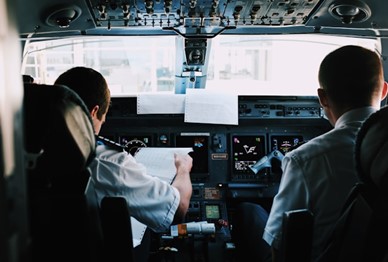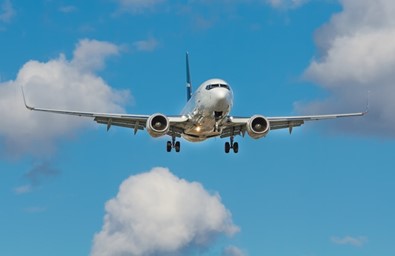Michael DelCiello works in the aviation industry. In the following article, Michael DelCiello discusses task saturation, and how to properly manage intense workloads for flight safety.
In the high-stakes world of aviation, pilots are entrusted with the safety of hundreds of passengers and crew each day, making split-second decisions in dynamic and often challenging environments. Central to their ability to perform effectively is the concept of task saturation – a phenomenon that occurs when pilots are bombarded with more tasks than they can effectively manage. This overload of responsibilities can lead to a cascade of cognitive challenges, ultimately jeopardizing flight safety.
Michael DelCiello Explains the Consequences of Work Overload
One of the primary consequences of work overload is diminished situational awareness. Situational awareness refers to a pilot’s perception and understanding of the current state of their aircraft, the surrounding airspace, and any potential hazards or threats. When pilots are overloaded with tasks, their ability to maintain a clear picture of the situation may be compromised. This can result in missed cues, delayed responses, or even a complete loss of awareness of critical factors, increasing the risk of errors or accidents.
Moreover, task overload can impair a pilot’s decision-making abilities. In the face of overwhelming demands, pilots may struggle to prioritize tasks effectively or evaluate alternative courses of action. They may resort to heuristic decision-making shortcuts or reliance on automated responses, which can be inadequate or inappropriate for the situation at hand. As a result, pilots may make suboptimal decisions or fail to take timely corrective action, further exacerbating the safety risks in the air.
Michael DelCiello also notes that this phenomenon occurs when pilots face an excessive cognitive load, surpassing their capacity to process information, make decisions, and execute actions. It’s akin to trying to juggle too many balls at once – eventually, one or more will be dropped. In the cockpit, this can manifest into critical errors that compromise the integrity of the flight.
At its core, task saturation is a critical issue in aviation because it directly impacts pilots’ situational awareness and decision-making abilities – two pillars of safe flight operations. When pilots are overwhelmed by the sheer volume of tasks demanding their attention, their ability to perceive and understand the full scope of the situation may be compromised. Michael DelCiello says that this can lead to tunnel vision, where pilots focus narrowly on immediate tasks while losing sight of broader situational cues or emerging threats.

Effects on Communication Among Crew
Additionally, task saturation can impede communication and coordination among crew members. Effective communication and teamwork are essential for safe flight operations, enabling pilots to share information, delegate tasks, and collaborate appropriately to address challenges. However, when pilots are overwhelmed by their individual workload, communication may become fragmented or ineffective, hindering coordination and increasing the likelihood of misunderstandings or errors.
To mitigate the risks associated with this, aviation authorities, airlines, and training organizations often implement various strategies and procedures. These may include:
- Crew Resource Management (CRM): CRM training emphasizes effective communication, teamwork, and decision-making skills among flight crew members. By fostering a culture of open communication and mutual support, CRM helps mitigate the impact of task saturation on flight safety. This training also equips pilots with strategies for managing workload effectively, including prioritizing tasks, delegating responsibilities, and maintaining situational awareness in dynamic environments. Michael DelCiello says that by fostering a culture of open communication and collaboration in the cockpit, CRM helps prevent critical errors by ensuring that workload is distributed evenly among crew members, reducing the risk of individual overload.
- Standard Operating Procedures (SOPs): SOPs provide pilots with structured guidelines for conducting flight operations, including protocols for task prioritization, workload management, and decision-making. Michael DelCiello says that adhering to SOPs helps pilots maintain consistency and discipline in their actions, even under challenging circumstances.
- Automation and Technology: Automation systems and advanced cockpit technologies assist pilots in managing complex tasks and reducing cognitive workload. However, pilots must remain vigilant and maintain proficiency in manual flying skills to effectively monitor and override automated systems when necessary. Furthermore, technological advancements in cockpit automation have been instrumental in alleviating some of the burdens associated with task saturation. Automated systems can assist pilots with routine tasks, such as navigation and systems monitoring, allowing them to focus their attention on higher-order functions like decision-making and problem-solving. However, Michael DelCiello emphasizes that while automation can be a valuable tool for workload management, it also introduces new challenges related to a pilot’s reliance on technology and their ability to intervene effectively in the event of system malfunctions or failures. Therefore, it’s essential for pilots to maintain proficiency in manual flying skills and remain vigilant in monitoring automated systems to prevent complacency.
- Fatigue Management: Fatigue can also exacerbate the effects of work overload by impairing cognitive function and decision-making abilities. Airlines implement fatigue risk management programs and scheduling practices to mitigate the risks of pilot fatigue and ensure that flight crews are adequately rested and alert during operations.

Final Thoughts
Michael DelCiello underscores task saturation as a critical concept in aviation, emphasizing its significance in ensuring flight safety. Task saturation highlights the crucial need for effective workload management among pilots to mitigate the risks associated with cognitive overload and maintain optimal performance in the cockpit.
Understanding the factors contributing to mental saturation is paramount for aviation professionals. Pilots must recognize the signs of cognitive overload and proactively implement strategies to address it. This may involve prioritizing tasks, delegating responsibilities, or leveraging automation systems to alleviate cognitive burden.
By adopting proactive measures to manage workload effectively, pilots can uphold situational awareness and decision-making capabilities – essential elements for safe flight operations. Furthermore, the implementation of Crew Resource Management (CRM) principles plays a pivotal role in fostering effective communication, teamwork, and collaboration among flight crew members.
Through ongoing training, scenario-based exercises, and adherence to standardized procedures, pilots can enhance their ability to navigate the complexities of the cockpit with confidence, even amidst challenging conditions. By prioritizing workload management and embracing a culture of safety, aviation professionals can ensure the safe and efficient operation of aircraft, safeguarding the well-being of passengers, crew, and the broader aviation community.







